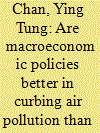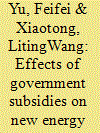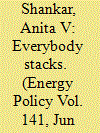|
|
|
Sort Order |
|
|
|
Items / Page
|
|
|
|
|
|
|
| Srl | Item |
| 1 |
ID:
175033


|
|
|
|
|
| Summary/Abstract |
The environmental impacts of macroeconomic policies, and their interaction with climate policies are under-researched in the existing literature. This paper compares the effectiveness of standard macroeconomic tools (fiscal and monetary policies) with carbon taxation in curbing air pollution by using an environmental dynamic stochastic general equilibrium (E-DSGE) model. We show how government expenditure, interest rate, and carbon tax rate should vary over time in order to stabilize carbon emission levels. We find that (i) while all the aforementioned policies could stabilize carbon emissions, their underlying mechanisms are different. Fiscal, monetary, and carbon tax policies, uniquely and respectively, lead to a reduction in abatement effort, income tax revenue, and general price level. (ii) With economic expansions driven by total factor productivity (TFP) shocks, fiscal policy is the only policy that could maintain the emission levels and simultaneously improve household welfare in term of consumption and labor. (iii) Regarding the interaction between carbon and macroeconomic policies, carbon taxation should complement monetary policy, while it should not respond to fiscal policy.
|
|
|
|
|
|
|
|
|
|
|
|
|
|
|
|
| 2 |
ID:
175026


|
|
|
|
|
| Summary/Abstract |
With state-led support being only temporary, attention has turned to retail electricity markets to provide long-term support for renewable electricity. Past research has focused on consumer preferences for green electricity, i.e. the demand side. We investigated the supply side by analyzing what suppliers selling green retail electricity products in the UK, Germany, France and Italy actually provide. Through content analysis of the online data provided by these companies, we found that most products in Germany and France rely on Scandinavian hydropower. Since almost all of these plants have been operating for decades, these products today cannot be said to effectively drive new renewable capacities. Products in the UK and Italy rely on sources which already have state-led support and thus also do not drive the expansion of renewables. In fact, none of the four countries has established a policy framework that successfully fosters the development of a voluntary market for green electricity capable of driving the expansion of renewables. Alignment between sustainable energy policy objectives, consumer demand, and supply-side offerings in a voluntary market might be improved by empowering consumers through a simplified and possibly state-led labeling scheme that focuses on environmental impact and includes minimum standards for performance.
|
|
|
|
|
|
|
|
|
|
|
|
|
|
|
|
| 3 |
ID:
175038


|
|
|
|
|
| Summary/Abstract |
To meet the Paris Agreement, Mexico is committed to reduce unconditionally 25% of its greenhouse gases emissions for the year 2030. Since the strategy to achieve the mitigation goals needs an increase in renewable energy sources, Mexico’s national climate change policy package has already been launched, including the deployment of 13.5 GW of wind, 1 of biomass, 0.7 of geothermal, 1.75 of hydropower and 10.4 of solar energy in the period 2018–2030. However, these green investments planned are below the scenario proposed by IRENA compatible with the Paris Agreement. This paper assesses Mexico’s green investments for the period 2018–2030 in terms of value added, employment, materials, land use, water and CO2eq emissions in a multiregional input-output framework and compare the results with the IRENA proposal. These green investments are expected to account for nearly an increase of 1% both of GDP and employment in Mexico and an expected mitigation of around 63 Mt CO2eq, once the new facilities are fully deployed. Nevertheless, the deployment and operation and maintenance phases will increase the emissions (0.82%), the water and material footprint (0.19 and 0.9%, respectively) and the land use (0.19%) with a substantial share of the positive and negative effects leakaged outside.
|
|
|
|
|
|
|
|
|
|
|
|
|
|
|
|
| 4 |
ID:
175036


|
|
|
|
|
| Summary/Abstract |
Coal power accounts for a major share within electricity production and significantly contributes to the overall greenhouse gas emissions in many European countries. According to official reports, Germany will not achieve its emission reduction targets in 2020. Therefore, a shut-down of coal capacities is currently being discussed and a plan is developed by the so-called Coal Commission.
In this study, we analyse the effects of a national coal phase-out policy on carbon emissions and prices, and compare these to the effects of EU-wide coal phase-out policies. Considering high CO certificate prices and ambitious renewable energy targets, a coal phase-out in Germany would have a minor additional impact on overall European emissions. An EU-wide coal phase-out however, would significantly reduce the emissions, by around 19%. Alternatively, a very high CO certificate price policy provides an even greater reduction in CO emissions.
|
|
|
|
|
|
|
|
|
|
|
|
|
|
|
|
| 5 |
ID:
175037


|
|
|
|
|
| Summary/Abstract |
In this study, subsidies are classified into government subsidies beforehand (GSB) and government subsidies afterwards (GSA). We examine the impacts of GSB and GSA on the financial performance of Chinese enterprises of New Energy Vehicle (NEV). Analyzing a dataset of Chinese NEV firms' financial performance from 2013 to 2017 with panel regression models, we demonstrate that the two forms of government subsidies have different impacts on New Energy Vehicle enterprises' performance. Specifically, we find a positive U-shaped relationship between GSB and financial performance and an inverted one between GSA and financial performance. We further investigate the moderating role of intelligent transformation in the relationships between government subsidies and NEV enterprises’ performance. Our empirical analysis suggests that intelligent transformation can improve the efficiency of GSA and weaken the negative effects of excessive GSA. These results highlight the importance of intelligent transformation for NEV enterprises, providing policy makers with new insights into NEV subsidy policies.
|
|
|
|
|
|
|
|
|
|
|
|
|
|
|
|
| 6 |
ID:
175024


|
|
|
|
|
| Summary/Abstract |
Stove stacking (concurrent use of multiple stoves and/or fuels) is a poorly quantified practice in regions with ongoing efforts to transition household energy to cleaner options. Using biomass-burning stoves alongside clean stoves undermines health and environmental goals. This review synthesizes stove stacking data gathered from eleven case studies of clean cooking programs in low- and middle-income country settings. Analyzed data are from ministry and program records, research studies, and informant interviews. Thematic analysis identifiedy key drivers of stove stacking behavior in each setting. Significant (28%–100%) stacking with traditional cooking methods was observed in all cases. Reasons for traditional fuel use included: costs of clean fuel; mismatches between cooking technologies and household needs; and unreliable fuel supply. National household surveys often focus on 'primary' cookstoves and miss stove stacking data. Thus more attention should be paid to discontinuation of traditional stove use, not solely adoption of cleaner stoves/fuels. Future energy policies and programs should acknowledge the realities of stacking and incorporate strategies at the design stage to transition away from polluting stoves/fuels. Seven principles for clean cooking program design and policy are presented, focused on a shift toward "cleaner stacking" that could yield household air pollution reductions approaching WHO targets.
|
|
|
|
|
|
|
|
|
|
|
|
|
|
|
|
| 7 |
ID:
175030


|
|
|
|
|
| Summary/Abstract |
This study contributes to the literature by examining the effects of four particular determinants of public attitudes towards power grid expansion projects, namely residents' perceived procedural fairness, their trust in actors involved in the planning procedure, their risk expectations, and their perceived benefits. By accessing data collected from residents living along and in the wider area of a controversially discussed grid expansion project in Germany, a theoretically derived path model was tested empirically by means of structural equation modeling. The findings revealed that perceived procedural fairness directly affected residents’ trust in actors and indirectly influenced their risk expectations, their perceived benefits, and attitudes. Trust exerted a significant influence on risk expectations, perceived benefits, and attitudes, whereas risk expectations and perceived benefits significantly affected attitudes. Overall, the findings provide novel insights into specific mechanisms that shape public attitudes towards the construction of new HVTLs and suggest that it is crucial for the competent planning authorities and transmission system operators to provide fair information and participation measures and establish a trustworthy relationship to local residents affected by the infrastructure project.
|
|
|
|
|
|
|
|
|
|
|
|
|
|
|
|
| 8 |
ID:
175029


|
|
|
|
|
| Summary/Abstract |
Premised on our contention about the narrowness of the contemporary, industry-centric, focus to understanding the causes for the underdeveloped state of electricity industry in PNG, this paper develops a governance perspective for facilitating such an understanding. The analytical framework employed for this purpose is informed by core tenets of the state-society relational theory. The analysis undertaken in this paper suggests that the development of electricity industry in PNG has been ad hoc in nature, typified by the prevalence of piecemeal efforts for redressing electricity issues of the time. Further, this ad hoc development is essentially reflective of the underlying crisis of governability, as indicated by persistent political instability and frequent changes of government. This crisis has arisen from the ubiquity of conflicts, at the local level, between the western-style formal governance framework adopted after independence, and the culturally-attuned informal governance framework that has existed in the local communities for centuries. In such environments, the government tends to focus on redressing the immediate threat of political survival. The question of long-term development of the country (including, electricity industry development) has therefore assumed a dormant role. Outcome is the persistence of underdevelopment of the electricity industry.
|
|
|
|
|
|
|
|
|
|
|
|
|
|
|
|
| 9 |
ID:
175039


|
|
|
|
|
| Summary/Abstract |
In this paper, we propose an Energy Policy with Equity (EPE) for India, which will fundamentally change the energy mix of the Indian economy towards clean, green energy and will guarantee universal access to formal sources of energy like electricity, up to a certain amount. Any carbon mitigation strategy needs to alter India’s dependence on fossil fuels, requiring a systemic overhaul of its energy mix. Implementing a carbon tax will mitigate emissions and mobilise revenue. While part of this carbon tax revenue could be used to change the energy mix, the other part could be used for an in-kind transfer of free energy, up to a limit, beyond which it becomes fully chargeable from the first unit consumed. This we call the Right to Energy programme. We find that in order to implement this programme and also to meet the global carbon reduction goals, the necessary tax would be $60.4 per metric ton of carbon dioxide. The free entitlement of fuel and electricity per household comes out to be 2268 kWh per annum, and there is an annual universal travel pass of $17.9 per person for use in public transport.
|
|
|
|
|
|
|
|
|
|
|
|
|
|
|
|
| 10 |
ID:
175035


|
|
|
|
|
| Summary/Abstract |
Sustainable Development Goal 7 and the Paris Agreement reiterate the importance of a worldwide uptake of renewable energy. However, the present growth rate of renewables in the global energy mix is too slow to meet international targets. There exists at present a wide range of institutions with different characteristics that work internationally to promote a steeper increase. Whereas previous studies have examined the institutional landscape for renewable energy and the considerable interactions occurring across institutions, it remains unclear what the implications of these institutional interactions are for effectiveness. This paper assesses how institutional interactions can strengthen effectiveness, by focusing on three multi-stakeholder partnerships for renewable energy. Based on an expert survey and semi-structured interviews, the study provides both theoretical and empirical contributions to understanding institutional interactions in relation to effectiveness. Moreover, it provides insights on how to strengthen the effectiveness of multi-stakeholder partnerships for renewable energy. Results show that different levels and types of institutional interactions may influence effectiveness differently, with the sharing of procedural information and coordination mechanisms being considered most fruitful to increase effectiveness. Importantly, however, such interactions should not harm the autonomy, nor the efficiency of multi-stakeholder partnerships.
|
|
|
|
|
|
|
|
|
|
|
|
|
|
|
|
| 11 |
ID:
175034


|
|
|
|
|
| Summary/Abstract |
Incentive-based demand response (DR) policy plays an important role in guiding residents' electricity consumption behavior. How to effectively implement the DR policy has become a scientific issue that needs to be addressed urgently. To this end, based on the data from large-scale DR trials and matching questionnaires, the policy implementation path has been analyzed. The results show that households responded to the DR policy saved 0.09 kW h more electricity in the 1.5-h response period than households that did not respond to the DR policy. On the management implementation side, the subsidy price is crucial. Community publicity can also enhance the electricity saving effect. It also has been found that the electricity-saving potential of the low-level community is relatively limited. On the households' response side, households with higher household incomes, younger income earners, more air conditioners and small appliances, and higher gas consumption have higher policy participation. The novelty and originality of this article is that the data collected through large-scale controlled trials are unique and valuable. And we creatively combined trial data and surveys data together, which will enable us to further explore the implementation-side management factors and response-side household attributes. At the end, we put forward systematic policy recommendations for the implementation of DR policy, which has important references significance for countries with similar regulated electricity markets.
|
|
|
|
|
|
|
|
|
|
|
|
|
|
|
|
| 12 |
ID:
175031


|
|
|
|
|
| Summary/Abstract |
This paper examines the link between farm electricity supply management in the context of Gujarat's feeder segregation program, “Jyotigram Yojana” (JGY), investments in fixed and variable farm inputs, and net farm income per acre using panel data from the 2004-05 and 2011-12 India Human Development Survey. Estimating panel fixed effects regressions, we find that exposure to JGY is associated with substitution away from diesel pumps, an increase in tubewell ownership, and greater likelihood of irrigating with tubewells. Further, there a positive and statistically significant correlation between JGY exposure and per acre cost of purchased water for irrigation. Consequently, we find a negative correlation between JGY exposure and net farm income per acre. We conclude that in the short-to-medium term concomitant increase in irrigation costs can negate the gains from more reliable but rationed farm electricity. Simultaneous policy measures alongside feeder segregation are thus needed to ensure affordable irrigation and subsequently farmers' welfare.
|
|
|
|
|
|
|
|
|
|
|
|
|
|
|
|
| 13 |
ID:
175032


|
|
|
|
|
| Summary/Abstract |
Energy poverty has evolved as an important issue of research from academic and policy perspectives during the last two decades. The energy poverty estimates exhibit widespread variations across regions, methodologies and datasets, making the task of energy and development policies challenging. The variations in energy poverty estimates necessitate a systematic and rigorous analysis of these empirical studies to obtain a true measure of energy poverty. The present study conducts a meta-analysis of 30 studies and 103 estimates of energy poverty. On average, 71.1 percent of the population in the overall sample studies has been identified as energy poor. High I-square statistic values suggest heterogeneity bias in the sample studies; therefore, analysis at the subgroup level has been conducted. Meta-regression analysis of overall sample and subgroups has identified type of methodology, citations, impact factor of the journal, regional dummies, average key crude oil price and gross domestic product as significant factors that explain heterogeneity in the energy poverty effect sizes. We recommend inclusion of local and regional factors in assessment of energy poverty for developing a uniform methodology to assess energy poverty across developing economies.
|
|
|
|
|
|
|
|
|
|
|
|
|
|
|
|
| 14 |
ID:
175027


|
|
|
|
|
| Summary/Abstract |
Americans strongly support policies aimed at increasing the use of renewable energy. Prior research has found that, overall, support for renewable energy tends to be motivated primarily by people's perceptions that it creates economic benefits and reduces environmental harms. However, the extant research has not established how these motivations vary across political segments. Here we investigate (a) if and how Republicans and Democrats differ in their stated motivations for supporting a transition to renewable energy, and (b) what demographic and attitudinal variables best predict Republicans' and Democrats' support for renewable energy policies. Using a nationally representative sample of American registered voters, we found a consistent pattern across multiple methods of analysis: Republicans' (compared to Democrats') support for renewable energy is driven more by considerations of economic costs/benefits, whereas Democrats' (compared to Republicans') support is driven more by concern about global warming. These partisan differences hold significant implications for those who seek to effectively tailor policy and strategic communication to these political segments.
|
|
|
|
|
|
|
|
|
|
|
|
|
|
|
|
| 15 |
ID:
175028


|
|
|
|
|
| Summary/Abstract |
Changes in the international balance of power, transformations in global energy markets, and the proliferation of new energy organizations have left the IEA facing a potential crisis. Traditionally scholars assume that international organizations, such as the IEA, have little autonomy to respond to changes in the international environment. While empirical studies have shown that this does not always match reality, almost no scholarship has focussed on these issues in the domain of energy. In particular, on the strategic role that international organizations can play in their own right and the impact this could have on the existing international energy architecture. This paper seeks to address this gap by focussing on the behaviour of the IEA since 2015 when it commenced a modernisation programme. Drawing on interviews with energy officials, it identifies the key pressures shaping the IEA's environment, the IEA's strategies in response, and the extent to which the IEA's has had autonomy from member states to pursue its strategies. The empirical analysis highlights that policymakers should pay greater attention to the strategic actions of organizations like the IEA and the way they can shape the contours of the energy domain.
|
|
|
|
|
|
|
|
|
|
|
|
|
|
|
|
| 16 |
ID:
175025


|
|
|
|
|
| Summary/Abstract |
Increasing renewable energy penetrations and low natural gas prices have increased the reliance of U.S. power systems on natural gas-fired generation. Increased reliance has sparked concerns over and resulted in natural gas deliverability constraints. To mitigate these constraints, research and regulatory reform have tried to improve coordination between power and gas systems. The U.S. Federal Energy Regulatory Commission (FERC) issued Order 809 in 2015 to improve day-ahead and intra-day coordination of power and gas systems. Given little research on intra-day coordination and FERC's recent action, we quantify the value of improved intra-day coordination between gas and electric power systems. To do so, we co-simulate coordinated day-ahead, intra-day, and real-time operations of an interconnected power and natural gas test system using a dynamic natural gas simulation model and a power system optimization model. We find intra-day coordination reduces total power system production costs and natural gas deliverability constraints, yielding cost and reliability benefits. Sensitivity analysis indicates improved intra-day renewable energy forecasts and higher renewable energy capacities increase intra-day coordination benefits for gas network congestion. Our results indicate FERC Order 809 and other policies aimed at enhancing intra-day coordination between power and gas systems will likely yield cost and reliability benefits.
|
|
|
|
|
|
|
|
|
|
|
|
|
|
|
|
|
|
|
|
|